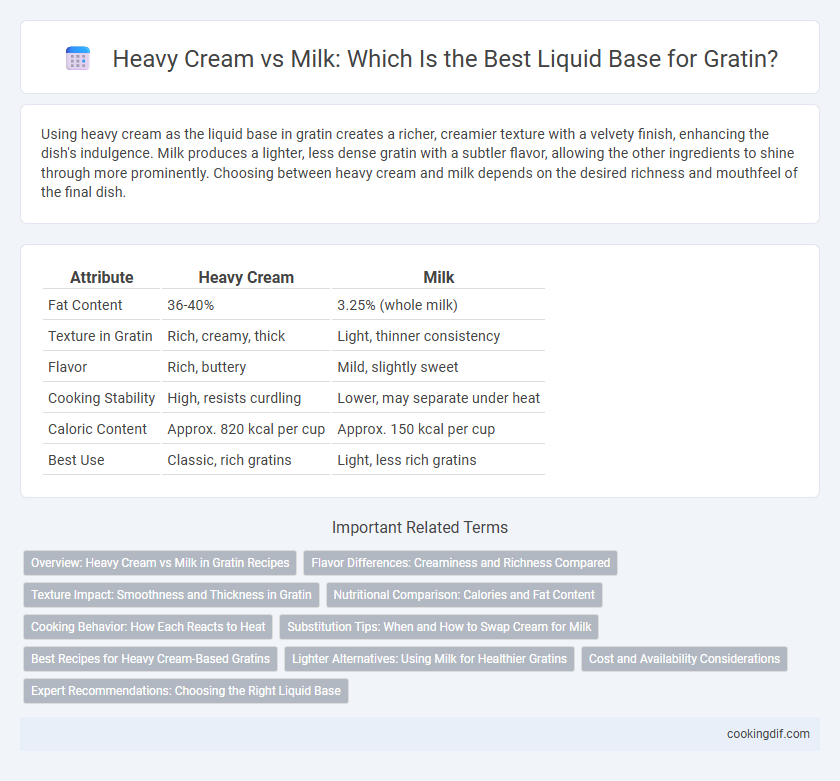Using heavy cream as the liquid base in gratin creates a richer, creamier texture with a velvety finish, enhancing the dish's indulgence. Milk produces a lighter, less dense gratin with a subtler flavor, allowing the other ingredients to shine through more prominently. Choosing between heavy cream and milk depends on the desired richness and mouthfeel of the final dish.
Table of Comparison
| Attribute | Heavy Cream | Milk |
|---|---|---|
| Fat Content | 36-40% | 3.25% (whole milk) |
| Texture in Gratin | Rich, creamy, thick | Light, thinner consistency |
| Flavor | Rich, buttery | Mild, slightly sweet |
| Cooking Stability | High, resists curdling | Lower, may separate under heat |
| Caloric Content | Approx. 820 kcal per cup | Approx. 150 kcal per cup |
| Best Use | Classic, rich gratins | Light, less rich gratins |
Overview: Heavy Cream vs Milk in Gratin Recipes
Heavy cream provides a rich, velvety texture and enhances the flavor depth in gratin recipes due to its high fat content, resulting in a luxurious, creamy sauce that browns beautifully. Milk offers a lighter alternative with fewer calories and less fat, producing a more subtle creaminess that allows the other ingredients, like cheese and vegetables, to shine without overwhelming richness. Choosing between heavy cream and milk depends on the desired texture and richness, with heavy cream favored for indulgent, thick gratins and milk suited for lighter, more delicate dishes.
Flavor Differences: Creaminess and Richness Compared
Heavy cream provides a richer, creamier texture in gratin dishes compared to milk due to its higher fat content, typically around 36-40%. Milk, with a lower fat percentage of about 3-4%, yields a lighter consistency and a more subtle flavor profile. Choosing heavy cream enhances the dish's indulgence by imparting a velvety mouthfeel and intensified dairy richness, while milk offers a less overpowering, delicate taste.
Texture Impact: Smoothness and Thickness in Gratin
Heavy cream creates a richer, smoother texture in gratin due to its higher fat content, resulting in a creamy, velvety consistency that enhances the dish's thickness. Milk produces a lighter, less dense sauce with a thinner texture, which may lead to a less cohesive gratin surface. Choosing heavy cream over milk significantly impacts the gratin's mouthfeel, providing a more luscious and indulgent finish.
Nutritional Comparison: Calories and Fat Content
Heavy cream contains significantly higher calories and fat content compared to milk, offering around 400 calories and 43 grams of fat per cup, while whole milk provides approximately 150 calories and 8 grams of fat per cup. The increased fat in heavy cream contributes to a richer texture and creamier consistency in gratins, enhancing flavor depth and mouthfeel. Choosing milk over heavy cream reduces calorie intake and fat consumption but results in a lighter, less decadent dish.
Cooking Behavior: How Each Reacts to Heat
Heavy cream maintains a rich texture under high heat, resisting curdling and providing a smooth, creamy consistency in gratins. Milk, with its lower fat content, is more prone to separation and curdling when exposed to prolonged or intense heat. The stability of heavy cream ensures a cohesive, velvety sauce, while milk may require careful temperature control to avoid graininess.
Substitution Tips: When and How to Swap Cream for Milk
Heavy cream provides a rich, velvety texture and higher fat content essential for creating classic gratins with a luscious, golden crust. When substituting milk for heavy cream, use whole milk combined with a small amount of melted butter or cornstarch to mimic the cream's richness and thickening properties without sacrificing flavor. For a lighter gratin, opt for low-fat milk but expect a less creamy texture, and ensure to whisk continuously to prevent curdling during baking.
Best Recipes for Heavy Cream-Based Gratins
Heavy cream enriches gratins with its high fat content, creating a velvety, luscious texture that enhances the dish's flavor profile more profoundly than milk. Recipes using heavy cream, such as potato or cauliflower gratins, offer a luxurious mouthfeel and golden, bubbling crust due to its ability to brown and thicken beautifully during baking. Milk-based gratins are lighter but often lack the depth and richness that heavy cream imparts, making heavy cream the preferred choice for indulgent, restaurant-quality gratin recipes.
Lighter Alternatives: Using Milk for Healthier Gratins
Using milk as a liquid base in gratins results in a lighter dish with reduced fat content compared to heavy cream. Milk provides sufficient moisture and helps maintain creamy texture while lowering saturated fat and calorie levels, ideal for health-conscious recipes. Opting for whole or 2% milk balances richness and health benefits without compromising flavor or consistency.
Cost and Availability Considerations
Heavy cream provides a richer, creamier texture for gratins but typically costs more and may be less readily available than milk in many grocery stores. Milk offers a more economical and accessible option, making it suitable for budget-conscious cooking without significantly compromising the dish's moisture content. Choosing between heavy cream and milk depends on balancing desired richness against cost efficiency and ingredient accessibility.
Expert Recommendations: Choosing the Right Liquid Base
Experts recommend using heavy cream over milk as the liquid base in gratin to achieve a richer, creamier texture and enhanced flavor. Heavy cream's higher fat content allows it to create a luxurious, velvety sauce that binds ingredients effectively while preventing the dish from drying out during baking. Milk can be used for a lighter alternative but may result in a thinner sauce and less intense flavor, making heavy cream the preferred choice for classic gratin recipes.
Heavy Cream vs Milk for liquid base Infographic

 cookingdif.com
cookingdif.com